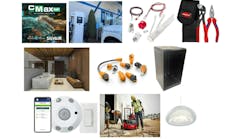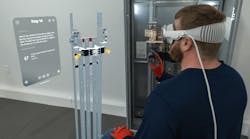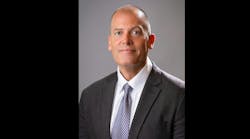-
It's the economy… Duh! Yes, everyone is searching for any inkling that the economic recovery is gaining speed, and EW's National Factbook on page 24 offers plenty of insight into the economic indicators that show where the market has been during the past year, just how bad it got over the past three years, and the niches in which the economy is showing its first signs of recovery.
But plenty of other news broke in the electrical wholesaling industry in 2010. If you can look past all the bad memories, it almost seemed like it was a ordinary year — companies were getting bought and sold, copper was going wild (and being stolen), and distributors, manufacturers and reps were mapping courses past economic obstacles to new market opportunities. These companies are sketching out new business models in potential new markets such as the smart grid, LEDs, electric vehicles and renewables that may one day dramatically change the product mix sold in the electrical wholesaling industry. Spend a few minutes reading this article about the 10 biggest news stories that broke during the past year and you will learn how some developing stories may reshape your company's future.
-
WESCO expansion highlights an active distribution market. WESCO Distribution Inc., Pittsburgh, Pa., may not make as many acquisitions as some of the more active acquirers in the electrical market. But when it does sign off on a deal, they are usually pretty interesting, because the companies it purchases usually have some sort of specialty. Its 2010 purchases of Potelcom Supply, Anchorage Alaska, a $25 million distributor that focuses on the telecom, utility, and industrial markets, and TVC Communications, Annville, Pa., a $300 million distributor of broadband communications products serving the cable, telecommunications and satellite industries, certainly follow this trend. Over the past decade or so WESCO has strived to be more than just another pipe-and-wire distributor by investing in some tightly focused niches, including voice/data/video (VDV), utility, industrial MRO, automation and green markets, and national accounts.
Going back a few years, it built its business in the VDV market with 1996 acquisitions of Communications Supply Corp. (CSC), Carol Stream, Ill., and EESCO, Chicago, and solidified its niche in national accounts with its 1998 purchase of Bruckner Supply, Port Washington, N.Y. In other 2010 WESCO news, the company announced that its Carlton-Bates industrial distribution business would co-locate with existing WESCO branches in Denver, Colo., and Indianapolis, Ind. By the way, WESCO's stock price at press-time in late November had doubled in the past 12 months.
WESCO wasn't the only distributor making acquisition news in 2010. Granite City Electric Supply Co., Quincy, Mass., merged with its sister company, Columbia Electric Supply, Brockton, Mass. Both companies were founded by Nicholas Papani nearly 90 years ago and were operated by his two daughters: Phyllis Godwin, Granite City Electric CEO and co-owner, and Dorothy Palmer, Columbia Electric's co-owner.
Other 2010 acquisitions included Graybar Canada's acquisition of AVAD Industrial Sales Inc., Sudbury, Ontario; the purchase by NESCO-Needham Electric Supply, Canton, Mass., of Densmore Electrical Supply, Rutland, Vt.; the deal where Cape Electrical Supply, Cape Girardeau, Mo., acquired Cumberland Electric Supply, Somerset, Ky.; Bloomfield, Conn.-based Kaman Industrial Technologies Corp.'s purchase of Minarik Corp., Glendale, Calif.; and Teleflex's sale of Southwest Wire Rope and Southern Wire to Houston Wire & Cable Co., Houston.
-
Manufacturers position themselves for growth in the smart grid, LEDs and renewables. You may be tired of reading about potential opportunities in LEDs, the smart grid and renewables, but you just can't overlook all of the action in the green niche, and in 2010 much of the green activity was in manufacturer acquisitions as companies moved boldly to bolster their businesses in different niches within the green market. Some of the biggest deals included the acquisition by Honeywell, Morris Township, N.J., of submeter manufacturer E-Mon, Langhorne, Pa.; Atlanta-based Acuity Brands' purchase of LED specialist Renaissance Lighting, Herndon, Va.; and Acuity's partnership with Samsung to jointly develop LED lighting; and two smart grid ventures — the move by Cooper Industries, Houston, to expand its RF wireless networking capabilities with the acquisition of Eka Systems, Georgetown Md., and Swiss/Swedish ABB's $1 billion-plus purchase of Atlanta-based Ventyx, a developer of energy management software for the smart grid. Later in the year, ABB purchased motor giant Baldor Electric Co., Fort Smith, Ark.
In other green news, Philips Lighting, Somerset, N.J., and Cree Inc., Durham, N.C., inked cross-licensing deal for LED lamp technology; GE partnered with Rambus Inc., Los Altos, Calif., to develop flat-panel LED lighting for the commercial market; Siemens AG moved into the offshore wind market with the $145 million acquisition of A2SEA A/S, a Danish offshore wind farm developer; and the PowerGen division of Milbank Manufacturing, Kansas City, Mo., expanded into wind turbines through an agreement with Endurance Wind Power, Vancouver, B.C., to build a dealer/installer network of certified electrical contractors.
Green deals weren't the only acquisitions of note in the electrical market during the past year. Ideal Industries made three major investments in its desire to manufacture more products in the United States with the purchases of three highly regarded tool manufacturers — Western Forge, Colorado Springs, Colo.; Pratt Read, Shelton, Conn., the third-largest manufacturer of screwdrivers; and SK Hand Tools, Corp., Chicago, which manufactures hand tools for professional mechanics.
Thomas & Betts Corp., Memphis, Tenn., also announced three interesting deals in 2010. It acquired U.K.-based Cable Management Group, which makes systems to protect electrical components from fire, dust, moisture and corrosion for approximately $110 million; bought the Swiss firm PMA AG, a manufacturer of cable protection systems; and announced the sale of its communications products business to Belden Inc., St. Louis, for $78 million. Belden also acquired GarrettCom, Fremont, Calif., a provider of advanced industrial networking products and smart-grid solutions.
Other headline deals in the 2010 electrical market included the acquisition by Southwire Inc., Carrollton, Ga., of American Insulated Wire (AIW) from Leviton Manufacturing Co. Inc., Melville, N.Y.; and the billion-dollar dual between Emerson Electric Co., St. Louis, and ABB for Chloride Group, London, and its UPS business. Emerson's bid of $1.49 billion beat ABB's final offer.
In other manufacturer news, Ferraz Shawmut announced that it would take on the name of its French parent and would now be called Merson USA, erasing the rich history of the Shawmut name in the U.S. fuse market; Federal Signal, University Park, Ill., purchased Sirit Inc., Toronto, an RFID manufacturer; Eaton bought Wright Line Holding Inc., Worcester, Mass., a manufacturer of data center enclosures and air flow management systems, as well as CopperLogic, Houston, a manufacturer of electrical and electromechanical systems related to Germany's Moeller Group, which Eaton bought in 2008; generator manufacturer Generac Inc., Waukesha, Wis., went public with an IPO.
-
Big manufacturers are going after turnkey electrical jobs. Electrical manufacturers including Eaton Corp., Cleveland; Schneider Electric, Palatine, Ill.; and Siemens Energy & Automation, Alpharetta, Ga., are winning turnkey project work where they provide the design, installation and often post-job electrical maintenance of electrical projects with federal agencies, universities and other big customers. Many of these projects are funded by federal stimulus funds through the American Recovery and Reinvestment Act (ARRA). Depending on the nature of the job and whether or not the customer wants a single point of contact, they may handle all electrical supply requirements themselves, leaving local distributors out of the equation. According to data compiled by Electrical Wholesaling from these companies' own project announcements, Eaton, Schneider Electric and Siemens together were awarded at least $114 million worth of these projects during the past year.
These companies also often have contracts with General Services Administration (GSA), the centralized procurement arm for the federal government. For instance, Siemens Government Services Inc. (SGS), Buffalo Grove, Ill., packages and integrates products from Siemens' businesses in the electrical, HVAC, security, and renewables markets to provide the GSA with one-stop source of supplies. In October it received a $38.5 million task order award from the GSA to implement energy efficiency improvements to 39 federal government facilities. Siemens will deliver renewable energy and building automation systems including solar generating technologies and sophisticated heating, ventilation and air conditioning (HVAC), advanced irrigation and lighting control systems. Water-conserving plumbing and energy-efficient lighting fixtures, heating and cooling system upgrades and building envelope improvements such as thermal pane windows and insulation will also be installed during the construction phase.
-
Electric vehicles (EVs) drive into electrical market. We won't see electric vehicles clogging up the interstates anytime soon, but we may one day remember 2010 as the year when electrical manufacturers starting laying the groundwork for EVs with some major investments in this potentially profitable technology for themselves, the electrical contractors who will install them and the electrical distributors that stock EV charging stations — or utilize electric delivery vehicles for local deliveries. When GE rolled out its WattStation in July, company executives said they expect 500,000 to 699,000 charging stations to be installed every year and that there will be a $5 billion global market for EV chargers by 2015. They expect that for every dollar spent on charging stations, 50 cents will be spent in sales of distribution equipment, switchgear and other electrical supplies needed to power these units and upgrade existing electrical systems. Other electrical manufacturers now involved in the EV market include Eaton, which announced plans to partner with Takaoka Electric Manufacturing Co., Ltd., Tokyo, to develop EV charging stations and to build EV chargers at a plant in Wilsonville, Ore.; Leviton, which is working with Coulomb Technologies, Durham, N.C., to develop EV chargers for Coulomb's ChargePoint network; and Schneider Electric, which has some preliminary EV development work now underway.
-
Copper went wild (again) in 2011. Anyone want to bet their house on where copper will be a year from now? No? I didn't think so. At press-time, copper was up approximately 28 percent from year-ago levels, but that can change in a matter of days. Welcome to the wild and wacky world of copper pricing, where a workers' strike in Chile, a whiff of inflation in China or a rumor of speculation can send this skittish market into a tizzy. While generally above last year's prices, during the past year copper pricing plunged several times to below $3/pound, increased more than a dollar/pound in less than five months, and then dropped 25 cents/pound in about five days. With the economy improving in 2011, one would think the laws of supply-and-demand would nudge prices up, but this theory tends to work in a “normal” market, and over the past few years copper pricing has been anything but normal. The best advice? Expect the unexpected.
-
Renewable energy is for real … on a regional basis. If you live in California, New Jersey, New Mexico or Massachusetts or other states where lucrative utility rebates and state and local incentive programs make paybacks for photovoltaic (PV) installations more palatable, you probably love solar. But if you live in many of the Midwestern states or anywhere else where utility or state incentives for solar installation are scarce, it's difficult to get potential customers to accept a return on investment for a PV installation that could reach a decade, and solar may not realistically be on your radar yet. However, there's still something remarkable about standing amidst the rows of solar panels on a 100,000-square-foot building and knowing that its rooftop PV panels are converting the sun's rays into electricity to power nearly everything that goes on in that building, from the coffee maker in the break room to every last light bulb and puff of cool air coming out the air conditioning vent, to dozens or maybe even hundreds of computers.
The wind market is also a very regional business, and if distributors and reps live in neighborhoods where financial incentives are cooking, they may be enjoying sales of electrical products for wind turbine installations. According to the American Wind Energy Association (AWEA), Washington, D.C., more than 33,900 wind turbines are producing an estimated 36,698 MW of electricity in the United States and an additional 6,300 MW of capacity is now under construction. But most of this being produced in these 14 states: Texas (9,727 MW); Iowa (3,670 MW); California (2,739 MW); Oregon (2,095 MW); Washington (1,964 MW); Illinois (1,848 MW); Minnesota (1,818 MW); New York (1,274 MW); Colorado (1,248 MW); Indiana (1,238 MW); North Dakota (1,222 MW); Oklahoma (1,130 MW); Wyoming (1,101 MW); and Kansas (1,026 MW).
AWEA says the on-again, off-again stream of incentives for wind projects has hurt construction of these projects in 2010, and that the U.S. wind energy industry just experienced its slowest quarter since early 2007. Wind developers added 395MW of wind power in the third quarter of 2010, 72 percent below this time last year. GE Energy and Siemens are big players in the wind market and account for many of the new installations.
-
End users start figuring out how to adapt tablet computers to their jobs, and distributors and manufacturers had better hope their product data is easily available in on these devices. Amongst the millions of tablet computers that Apple and other computer manufacturers will sell in 2010, some will be bought by electrical contractors and other end users who figure their mobility will be handy on the jobsite. Users are beginning to integrate them into their work processes somewhere between a smartphone and a laptop computer.
Some early indications show that tablet computers like the iPad will become popular tools on the jobsite because of their large screen size, simple navigation and wireless connectivity. A recent cover story in Engineering News-Record described a scene where project managers and engineers on the Texas construction site of a 285-room Embassy Suites huddled with their iPads and other tablet computers and smartphones to jointly access the cloud-based architectural drawings for the hotel, making changes on the fly and automatically downloading the changes into spreadsheets that were emailed to any subcontractors that needed to be notified. It sure would make sense for all of the online electrical product data needed in these informal huddles to be up to snuff.
Then there's the story behind the story of the acquisition of Accubid Systems, Concord, Ontario, one of the largest estimating packages in the electrical market, by Trimble, Sunnyvale, Calif., a provider of building information management systems (BIM). Trimble sees Accubid as a key piece of its plans to help contractors use rugged tablet computers to access design, bidding and estimating and product data on job-sites.
-
Ballast shortages and a computer virus make headlines. Unforeseen news events sometimes come onto the scene and command the attention of the entire electrical market. During the past year, a shortage of electronic ballasts at mid-year put electrical distributors' customer relationships to the test. Ballast manufacturers apparently couldn't get enough of certain electronic components that are used in the ballasts as well as flat-screen video displays and smart phone displays.
The Stuxnet computer virus also grabbed its share of attention when it was discovered in Siemens industrial automation equipment where Siemens WinCC or PCS7 software is installed. But according to a posting on a Siemens website, it hasn't done as much damage as some people may think. According to information on Siemens' website, “In the four months since Stuxnet appeared for the first time, a total of 22 Siemens customers worldwide from an industrial environment have reported an infection with the Trojan (as of Nov. 22). In all cases the malware could be removed. In none of these cases did the infection cause an adverse impact to the automation system.”
-
Who's who at the zoo. Some of the nation's largest electrical distributors had some major changes in the executive ranks. At Rexel USA, Dallas, Mark Daniel is now senior V.P. and general manager with leadership responsibility for the U.S. organization. At Consolidated Electrical Distributors Inc., Irving, Texas, Randy Eddy replaced Richard Worthy as the senior executive at USESI/ Consolidated Electrical Distributors, Exton, Pa., after serving CED in a regional V.P. post.
Crescent Electric Supply Co., East Dubuque, Ill., also made some major moves. Marty Burnbridge was promoted to president and CEO; Richard Cody is V.P. of supplier management; Richard Schmid is now senior V.P.; and former Graybar senior executive Dennis DeSousa joined the company as senior V.P. of business development. HD Supply, Atlanta, made headlines, too, with the news that John Stegeman, former president and CEO of Ferguson Enterprises, Newport News, Va., is executive V.P. and will lead the company's North American business units.
In other major changes at electrical distributors, Jim Gottschalk was appointed CEO of Power/Mation, St. Paul, Minn. He was most recently with Hartford Electric Supply Co. (HESCO), Hartford, Conn., in an executive post and also held management positions with McNaughton-McKay, Rockwell Automation and Ford. George Vorwick is now CEO at United Electric Supply Co., New Castle, Del., replacing Tom Cloud, who has retired, and Bill Kuemphel is now president of Butler Supply Inc., Fenton, Mo., succeeding John Duda, who remains as chairman.
Electrical manufacturers. Several manufacturers appointed new presidents or chief executive officers. Jeff Drees is now president of U.S. operations for Schneider Electric, Palatine, Ill.; Richard Holder is now president of Eaton's newly formed Electrical Components Organization, reporting to Jerry Whitaker, president, Americas Region; Rick Boutilier is now president and CEO of Intermatic, Spring Grove, Ill., after serving as CFO and COO at the company; Laura Ulz was named president of Cooper Tools, Apex, N.C.; Ron Sege was appointed president and CEO of Echelon Corp., San Jose, Calif.; and Jaime Irick is leading GE Lighting Solutions and is reporting to Michael Petras, CEO of GE Lighting.
Thomas (Andy) Blanchard is now CEO of United Copper Industries, Denton, Texas, coming to the company from RevWires LLC; James Bolch is the new president and CEO for Exide Technologies, Milton, Ga., coming to the company from Ingersoll Rand; Karen Oweyeung, formerly with Hewlett Packard and Lumileds, is the new CEO at Lunera Lighting, Redwood City, Calif.; and Kyle Spader will become president of the U.S. division of IEWC Global Solutions, New Berlin, Wis., effective Jan. 1.
In other executive promotions, Neil Scrimsher was appointed executive vice president, Cooper Connection, for Cooper Industries, Houston; and Tom Schottes, is senior V.P. of the new Professional Lighting, Solid-State Lighting and Light Management groups at Osram Sylvania.








